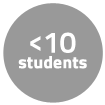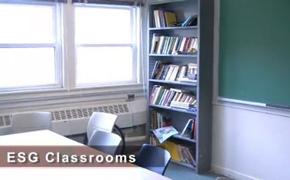This Course at MIT pages are part of the OCW Educator initiative, which seeks to enhance the value of OCW for educators.
This Course at MIT pages provide context for how the course materials published on OCW were used at MIT. They are part of the OCW Educator initiative, which seeks to enhance the value of OCW for educators.
Course Overview
This page focuses on the course SP.292 Writing Workshop as it was taught by Jessica Young in Spring 2008.
The course was about encouraging students to think deeply and creatively, and giving them the tools to put their thoughts into writing. Students wrote in multiple genres (short stories, poetry, prose-poetry), with a focus on trying as many exercises and projects as possible (versus writing just a couple of pieces and working on them exclusively throughout the semester). The class was small, and involved ample discussion, workshop, and in-class activity.
The Experimental Study Group sponsors 5–10 six unit pass / fail seminars each spring on a variety of innovative subjects not covered in the regular curriculum. These seminars are open to all MIT students, as well as ESG students, and are intended to be hands-on and experiential in nature.
Course Outcomes
Course Goals for Students
The hope is that students exited the course with a deeper understanding of themselves, of what writing offers, and of how to navigate the covered genres. A personal goal of mine was to help students with their confidence in writing–especially at MIT where we think of ourselves more as brains than as hearts. It seems important to show students just how capable they are in this creative realm, and just how rewarding such participation is.
Possibilities for Further Study/Careers
This is a great set-up course for any kind of creative writing course–from a poetry workshop to science fiction writing to something involving digital media.
Curriculum Information
Prerequisites
None
Requirements Satisfied
None
Offered
This course was offered one time in the Spring of 2008.
Assessment
This course was graded as on a Pass/D/Fail basis. This means a student could either pass the course, receive a D grade, or fail the course. Learn more about student grading.
Intructor Insights on Assessment
The class was graded pass/fail. As long as a student participated fully in the course and produced successful work, they passed. Beyond that, the real pleasure was writing letters to students about their work. Each time students turned in a piece of work (which was at least once a week), I wrote them a letter in response. Like in a workshop, I addressed both the piece’s successes and areas needing improvement. This way I was able to offer personalized feedback on each piece while building a sense of each writer as a whole. For example noticing over several assignments that a writer had trouble with analogies, even if its not something I cover in the class, I could then still meet with that person to help him/her.
Student Information

Breakdown by Year
- All levels of undergraduates
- Graduate students
Breakdown by Major
Students came from a variety of majors.
Typical Student Background
Many students took this elective course out of curiosity. Most came to it feeling hesitant about writing, but eager to explore. They would say things like “I’ve never liked my English classes, but I can’t stop reading Asimov.” So there was an interest in the written word, whether or not there was previous success in an academic setting. From my own perspective as the teacher, I can say that there was a lot of talent and willingness to take risks (a great thing in writing!). The students tended more toward experimental writing, so I tweaked the class to involve more of that–lots of contemporary, quirky material.
Ideal Class Size
I absolutely think there is an ideal class size. A class such as this should be intimate, such that it feels safe and rigorous, and such that everyone’s voice can really be highlighted. You need a core number of people to have a full conversation (say, 6), and at some point there are too many voices (say, 12). So anything between there, and you’re golden.
During an average week, students were expected to spend 6 hours on the course, roughly divided as follows:
In Class
Met 1 time per week for 2 hours per session; 16 sessions total.
I preferred to keep reading in the classroom to a minimum, as we had only so many hours together each week. So any worksheets or workshop prep happened as homework. In class, then, we focused on discussion and activity. A discussion, for example, was about teasing apart a prose-poem we’d read for homework: What is the writer saying, what techniques does the writer use, how satisfying is the piece and why? An activity, for example, was about doing something together to practice a technique within writing. So we might sit with our eyes closed and discuss the feeling of sitting in a chair, working on how to offer sensory description in an exact and original way.
Out of Class
Students spent their out-of-class hours reading and writing, with the focus placed on writing. Each week students spent up to one hour reading materials for the course. The other three hours were for writing new material and/or revising previously written material. Even if an assignment one week was short, I asked students to spend the full three hours writing. For example, I might ask students to try the same short assignment a couple of times, answering the assignment in vastly different ways. So even a two-page write-up became a source of practice and exploration.
Semester Breakdown
| WEEK | M | T | W | Th | F |
|---|---|---|---|---|---|
| 1 |  |  |  |  |  |
| 2 |  |  |  |  |  |
| 3 |  |  |  |  |  |
| 4 |  |  |  |  |  |
| 5 |  |  |  |  |  |
| 6 |  |  |  |  |  |
| 7 |  |  |  |  |  |
| 8 |  |  |  |  |  |
| 9 |  |  |  |  |  |
| 10 |  |  |  |  |  |
| 11 |  |  |  |  |  |
| 12 |  |  |  |  |  |
| 13 |  |  |  |  |  |
| 14 |  |  |  |  |  |
| 15 |  |  |  |  |  |
| 16 |  |  |  |  |  |
 No classes throughout MIT
No classes throughout MIT Class session
Class session No class session scheduled
No class session scheduled Assignment due date
Assignment due date
A personal goal of mine was to help students with their confidence in writing–especially at MIT where we think of ourselves more as brains than as hearts.
—Jessica Young
Below, Jessica Young describes various aspects of how she taught SP.292 Writing Workshop.
Benefit of Workshops
Workshops are a huge part of many writing courses, as they offer students a way to build reader awareness, and teach students how to talk about writing in a professional and helpful way. In my classroom, we workshopped several pieces for each student, always starting with ample and genuine praise, and then moving into what the writer could work on to improve the piece. As with any class, such a wonderful part of workshop was just seeing how other people responded to the assignment, and learning both from their writing, and from yourself in talking about someone else’s writing.
Overcoming Challenges
The amount that the students enjoyed reading for pleasure varied greatly. There can be a short story that I think is absolutely miraculous, and a fine example of the writing techniques I’m hoping to teach. But another person can find that story totally atrocious, and not want to learn from it at all. So a difficult part of the material was finding the actual material–finding pieces that would please but also challenge. It’s okay if the class doesn’t all love a piece (in fact it’s quite helpful to discussion and learning if there’s some disagreement), but it’s important that everyone finds the piece to be worthwhile. As for how I overcame this challenge, I very carefully chose pieces that offered variety, and were all pieces that I personally stood by. As the term progressed and I came to know the students and their preferences, I could also pick out readings tailored to what would most interest and help them. And then in class I directly stated that it was okay if people didn’t like certain pieces, but that we should still be able to learn from everything we read.
Preparing for the Semester and Class Sessions
I designed the entire course, from what we read, to what we wrote, to what exercises we did, and when all of this was happening. I did a huge amount of the planning work upfront; while the calendar always changes based on student interest and success, in general I know—before the semester even starts—what we’re doing, say, in minute 30 of week 10. So before each class session, I just refreshed myself on the material. The bulk of the work during the term, then, was offering feedback on student work and altering the calendar as necessary.
Teaching the Course
The course was a lot of fun. I remember laughing and smiling a lot, and looking forward to our meetings. I generally feel this way with teaching, but there’s something about such an intimate (small) creative writing class that was invigorating. Even if people using OCW aren’t able to have that exact experience, I hope they’ll approach the materials I’ve shared with a sense of joy and lightness.


 Room 1 of 1
Room 1 of 1 